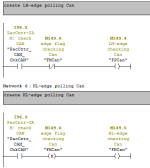Gentlemen and Ladies(maybe?),
So Im working to debugging a program for one of our presses and I have come accross a funny usage of the negative edge detection instruction.
I was always under the impression that the memory bit that you use for your (N) instruction, should'nt be used anywhere else in the program.
In the attached picture you will see that they reference it elsewhere, and this is'nt the only location where this takes place.
Has anyone else come across something like this? This press has a lot of devices communicating and its just been pretty buggy from the get go.
Thanks in advance,
Added a higher quality image

So Im working to debugging a program for one of our presses and I have come accross a funny usage of the negative edge detection instruction.
I was always under the impression that the memory bit that you use for your (N) instruction, should'nt be used anywhere else in the program.
In the attached picture you will see that they reference it elsewhere, and this is'nt the only location where this takes place.
Has anyone else come across something like this? This press has a lot of devices communicating and its just been pretty buggy from the get go.
Thanks in advance,
Added a higher quality image

Last edited:



